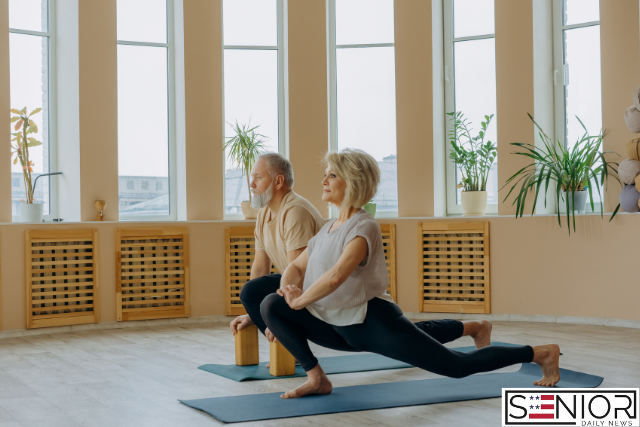Stretching Routines That Help with Senior Flexibility

As we age, staying active and mobile becomes more important than ever. While maintaining cardiovascular health and muscle strength often take center stage, one area is often overlooked — flexibility. Stretching is one of the simplest yet most powerful ways to support flexibility, mobility, and overall well-being as we get older.
Flexibility allows seniors to continue enjoying daily activities without discomfort or risk of injury. From reaching for items on a shelf to bending down to tie shoes, flexibility plays a major role in maintaining independence and quality of life.
The good news is that incorporating simple stretching routines into your daily habits can make a big difference. In this article, we’ll explore why flexibility matters for seniors, which stretches are most effective, and how to create a safe and sustainable stretching routine.
Why Flexibility is Important for Seniors
As we age, natural changes occur in our muscles, tendons, and joints. Muscle mass tends to decrease, joints can become stiffer, and connective tissues may lose elasticity. This leads to:
- Reduced range of motion
- Increased risk of falls and injuries
- Difficulty performing daily tasks
- Aches and stiffness
Regular stretching can help counteract these changes. Some key benefits include:
- Improved mobility and ease of movement
- Better posture and balance
- Reduced muscle tension and pain
- Enhanced circulation and relaxation
- Lower risk of falls
In short, stretching supports both physical health and mental well-being in seniors.
How to Get Started with Stretching
Before jumping into specific stretches, it’s important to know how to approach stretching safely, especially for older adults.
Warm up first with light movement such as walking or marching in place for 5-10 minutes.
Stretch slowly and gently — never force a movement or bounce.
Hold each stretch for 20 to 30 seconds, breathing deeply and staying relaxed.
Avoid pain — stretching should feel mild and comfortable, not painful.
Aim to stretch major muscle groups daily or at least several times per week.
Now let’s dive into some simple yet effective stretching routines that can help improve flexibility for seniors.
Simple Stretching Routines for Seniors
Neck and Shoulder Stretches
Neck and shoulder tension is common, especially in seniors who may spend time reading, watching TV, or working on hobbies.
Neck Side Stretch
Sit or stand tall.
Tilt your head gently to one side, bringing your ear toward your shoulder.
Hold for 20 seconds and repeat on the other side.
Shoulder Rolls
Sit or stand comfortably.
Roll your shoulders forward in slow, gentle circles 10 times.
Repeat rolling backward.
These stretches help relieve tension and improve mobility in the neck and shoulders.
Upper Back and Chest Stretches
Maintaining an open chest and strong back improves posture and reduces stiffness.
Chest Opener
Stand tall and clasp your hands behind your back.
Gently pull your arms back while lifting your chest.
Hold for 20 to 30 seconds.
Upper Back Stretch
Sit on a chair and clasp your hands in front of you.
Push your hands forward as you round your upper back and drop your chin to your chest.
Hold for 20 to 30 seconds.
These stretches release tightness from the upper body and encourage upright posture.
Arm and Wrist Stretches
Staying flexible in the arms and wrists helps with everyday tasks like cooking, writing, and lifting.
Overhead Arm Stretch
Raise one arm overhead.
Bend the elbow to touch your upper back.
Use the opposite hand to gently press on the elbow for a deeper stretch.
Hold for 20 seconds and switch sides.
Wrist Stretch
Extend one arm in front of you with the palm facing up.
Gently pull back on your fingers with your other hand.
Hold for 20 seconds and switch sides.
These moves help maintain mobility and reduce stiffness in the upper extremities.
Hip and Leg Stretches
Hips, thighs, and calves often become tight with age, leading to balance issues and reduced mobility.
Seated Hamstring Stretch
Sit on the edge of a chair.
Extend one leg straight with your heel on the floor.
Lean forward slightly, keeping your back straight.
Hold for 20 seconds and switch legs.
Hip Flexor Stretch
Stand near a wall or chair for support.
Step one foot back and bend your front knee.
Press your hips forward until you feel a stretch in the front of the hip.
Hold for 20 seconds and switch legs.
Calf Stretch
Stand facing a wall.
Place your hands on the wall and step one foot back.
Keep the back leg straight and heel on the ground.
Hold for 20 seconds and switch sides.
These lower body stretches support balance, walking, and standing comfortably.
Ankle and Foot Stretches
Healthy feet and ankles are key to mobility and fall prevention.
Ankle Circles
Sit or lie comfortably.
Lift one foot and rotate the ankle slowly in circles.
Do 10 circles in each direction per foot.
Toe Flex and Point
Sit or lie comfortably.
Point your toes forward and then flex them back toward your body.
Repeat 10 times.
Keeping the feet and ankles flexible supports overall stability and movement.
Tips for a Safe and Enjoyable Stretching Routine
Consistency is more important than intensity. Aim to stretch daily if possible, even if just for a few minutes.
Breathe deeply during each stretch to encourage relaxation.
Listen to your body and avoid pushing into pain.
Use props such as chairs, straps, or pillows to support safe stretching.
Consider joining a senior stretching or yoga class for motivation and guidance.
FAQs About Stretching for Senior Flexibility
Q1: How often should seniors stretch?
Ideally, seniors should stretch daily or at least three to five times a week. Consistency helps maintain flexibility and prevent stiffness.
Q2: Is it ever too late to start stretching?
No. It’s never too late to begin stretching. Even seniors with limited mobility can benefit from gentle stretches done regularly.
Q3: Can stretching prevent falls?
While stretching alone doesn’t prevent falls, it improves flexibility and balance, which significantly lowers the risk of falls.
Q4: Should I stretch before or after exercise?
It’s best to do dynamic movement before exercise and static stretching after exercise when muscles are warm.
Q5: What if I feel pain while stretching?
You should never feel pain. If stretching hurts, ease off and modify the stretch. Consult a healthcare provider if discomfort persists.
Image Designed Using Canva






